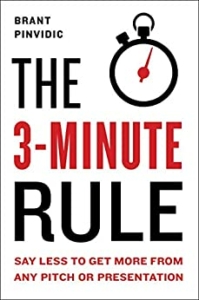 Today’s guest blog post was contributed by Certified Business Coach Andrew Valley of Westerfield, Ohio. With over 40 years of experience managing businesses and team, Valley has a proven track record of growing sales and profits. The ActionCoach may be contacted at andrewvalley@actioncoach.com or by phone at 614 746 5969.
Today’s guest blog post was contributed by Certified Business Coach Andrew Valley of Westerfield, Ohio. With over 40 years of experience managing businesses and team, Valley has a proven track record of growing sales and profits. The ActionCoach may be contacted at andrewvalley@actioncoach.com or by phone at 614 746 5969.
Don’t tell them what you do. Tell them what you do for them.
As a business owner, whether you’re a trades-based business, a restaurant, or are in professional services, one of the biggest challenges you’ll face is telling others what you do. Most people are only interested if what you do fits with what they need or want; otherwise they are not interested. You must tell the listener how your product or service can benefit that person, and how you can do it better or differently than others who do what you do.
So how can you differentiate your business from others in your category? The most powerful tool you can use to stand head and shoulders above your competition is your Unique Selling Proposition (USP). Your USP communicates the singular, unique benefit that your customers can expect to receive when they favor your business instead of your competitor’s – stated in specific, graphically illustrated terms. It will make you the obvious choice and lead prospective customers to the conclusion, “I would have to be an absolute fool to do business with anyone but you…regardless of price.”
A USP Will Raise Your Business Above The NOISE
Our communication habits spill over into marketing and advertising all the time. Show me 99% of all marketing material created and I’ll show you a huge jumble of hyperbole, fluff, platitudes, and yawnably unbelievable, black hole nothing words. Words like cheapest, professionalism, service, quality, speedy, convenient, and best. These words do absolutely nothing to communicate why you’re the best deal. Claude Hopkins, the greatest advertising man in history, summed it up: “Platitudes and generalities roll off the human understanding like water from a duck. They leave no impression whatsoever.”
The concept of “USP” is credited to Rosser Reeves, chairman of the Ted Bates & Co. advertising agency in the 1950s, and his definition of what makes a USP holds true today: * All advertising must make a proposition to the customer: Buy this, and you will receive a specified benefit.
- The proposition must be unique; something competitors cannot claim or have not chosen to emphasize in their promotions.
- The proposition must be so compelling that it motivates individuals to act.
A unique selling proposition (USP) is a succinct, memorable message that identifies the unique benefits that are derived from using your product or service as opposed to a competitor’s. A USP should be used as a strong and consistent part of an advertising campaign. It can be painted on the company’s cars or trucks, printed on the letterhead, and used in the packaging copy. It becomes, essentially, a positioning statement—a declaration of your company’s unique standing within the marketplace as defined by your product’s benefits.
Often a USP is a quick and snappy condensation of the company’s strategy. To expect consumers to remember a continually changing or drawn-out message is a near-futile hope. It is particularly important that a USP immediately convey one of the strongest competitive advantages of using your product. Marketers should strive to create a significant perception of difference between their product and the offerings of competitors. Developing a USP that accomplishes this task is called product differentiation.
Here’s an example of an effective USP from a well-known company in an extremely competitive industry. This company became the biggest in their field entirely because of their USP. The company is Domino’s Pizza. Consider Domino’s USP: “Fresh, hot pizza delivered to your door in 30 minutes or less, guaranteed!” This USP built Domino’s into a pizza empire!
Things to Consider in building your USP
Study your Competitors: research what they are using as a USP. It is difficult and expensive to challenge a competitor for a position already occupied, because of the “anchoring” phenomenon. When you know your competitors’ positions, you can choose to avoid direct challenges and instead carve out your own niche, where you can be both first and best. The easiest way into a person’s memory is to be first. Don’t be an also-ran.
Differentiate your Product or Service: Your prospects must see you as having something different, something special that sets you apart from the others in your industry. Otherwise, there is no reason for them to call you. They may call your competition, or they may decide not to call anyone at all. So, consider these questions:
- Who you are
- What you do
- Why you’re different
- How you can benefit your prospects – a feature may be useful but a benefit is a solution to a problem or a fulfillment of a need.
There should be a lot of difference between you and others doing the same kind of work. If there aren’t then you’re not paying close enough attention or you need to invent some unique things that others don’t do.
What else can you do?
Brainstorm with your team. Interview and survey your current and past customers. Ask them why they bought from you rather than your competition. What are they looking for in a provider of your product or service? What is important to them when making a buying decision? What feature or benefits do they value most or would like to see added to your product or service?
Once you have settled on the most unique and compelling feature of your product or business, begin to distill it down to one paragraph that clearly communicates and sums up why your customers should buy from you. This paragraph can be used on your website or in your marketing materials where you have more room to explain the unique benefits that you bring to your customers. However, it is still too long to be used as a tagline or slogan.
You still need to distill your USP down to one or two focused sentences that clearly and concisely communicate the benefits of your USP to your customers. This statement should leave no question in your customers’ mind about what you do and how you are different than your competition.
This USP statement will become your tagline or slogan. Integrate your USP statement into everything you do. Put it on every page of your website, on your letterhead, in all of your advertising and marketing. Communicate it to your employees, managers, and staff. Let it infuse into your corporate culture. Every time you talk to your customers, employees, or suppliers you should mention this USP. You cannot just give lip service to your USP, you must live it and breath it! It must become a part of you.
Every product, business or service has (or can have) a USP that makes it stand out from the competition. It is up to you to discover or create this element of uniqueness. Differentiate yourself, your business and your products from your competition and watch the sales pour in!











Follow us online!